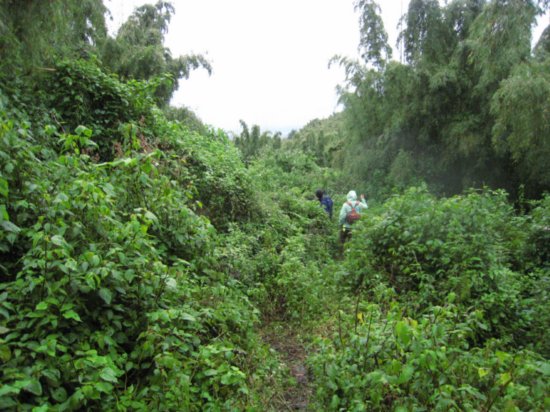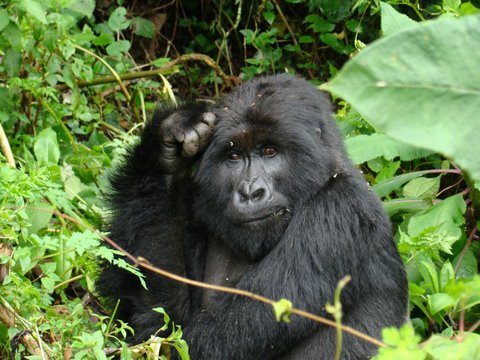Visiting the Gorillas
Hiking up to the Gorillas
By Regina Yando

At the park headquarters, you’re separated out into groups — I think it’s just seven people per group, along with a couple of trackers and your group leader. Different groups go out and see different families of gorillas. You don’t all go to the same place.
It’s a little annoying if you happen to be an older person like I am because they think you can’t make it above the lower levels. You really have to fight if you want to go up to see the Susa gorillas. They’re the biggest group, but it’s also the farthest away one. People who know something about gorillas want to see the Susa group because it still has one of the old gorilla ladies from Dian Fossey’s group. I think it’s the last gorilla from her studies there. It’s one of the largest groups, and I think it had maybe three silverbacks – they’re the big males. Which is unusual. Mostly it’s one silverback and ladies and babies.
 Before you go up, the group leader tells you about your group of animals that you’re going to see. They give you all the instructions: You’re not to approach them. You have to stay a certain distance away.
Before you go up, the group leader tells you about your group of animals that you’re going to see. They give you all the instructions: You’re not to approach them. You have to stay a certain distance away.
We set off at seven in the morning, and we must have walked up the mountain five hours to get there. You go through a bamboo forest. It’s a tough climb. You have to be in fairly good shape. I’m a runner, so I run four miles every morning. But by the time I got up there, I was feeling it a little bit … well, it tends to be muddy in places and slippery, and there’s no paths. You’re going through brush and what-have-you to get up. That’s because the gorillas don’t follow a path.
The trackers go ahead of you, early in the morning, so they have some idea of where the gorillas are. They can hear them way before any of us can. They talk to them in gorilla-ese to let them know we’re coming and all that. The guides are also watching for other animals on the mountain also, and occasionally for Congolese people who have gotten lost.
When you get close to the gorillas, the guides stay back, and the trackers lead you in. We had three trackers, because there were about 40 gorillas — which is very unusual. Most of them are eight, ten and sometimes fewer. You go very slowly and when the trackers spot the gorillas, what happens is you sit and you wait. The trackers bring you in as close as you’re permitted, but then it’s up to the gorillas.
